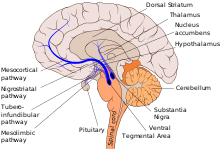Mesocortical pathway
The mesocortical pathway is a dopaminergic pathway that connects the ventral tegmentum to the prefrontal cortex. It is one of the four major dopamine pathways in the brain. It is essential to the normal cognitive function of the dorsolateral prefrontal cortex (part of the frontal lobe), and is thought to be involved in cognitive control, motivation, and emotional response.[1][2]

This pathway may be the brain system that is abnormal or functioning abnormally in psychoses, such as schizophrenia.[3] It is thought to be associated with the negative symptoms of schizophrenia, which include avolition, alogia and flat affect. This pathway is closely associated with the mesolimbic pathway, which is also known as the mesolimbic reward pathway.
Other dopamine pathways
Other major dopamine pathways include:
See also
References
- Malenka EJ, Nestler SE, Hyman RC (2009). "Chapter 13: Higher Cognitive Function and Behavioral Control". Molecular neuropharmacology: a foundation for clinical neuroscience (2nd ed.). New York: McGraw-Hill Medical. p. 318. ISBN 978-0-07-148127-4.
Therapeutic (relatively low) doses of psychostimulants, such as methylphenidate and amphetamine, improve performance on working memory tasks both in individuals with ADHD and in normal subjects. Positron emission tomography (PET) demonstrates that methylphenidate decreases regional cerebral blood flow in the dorsolateral prefrontal cortex and posterior parietal cortex while improving performance of a spatial working memory task. This suggests that cortical networks that normally process spatial working memory become more efficient in response to the drug. Both methylphenidate and amphetamines act by triggering the release of dopamine, norepinephrine, and serotonin, actions mediated via the plasma membrane transporters of these neurotransmitters and via the shared vesicular monoamine transporter (Chapter 6). Based on animal studies with micro-iontophoretic application of selective D1 dopamine receptor agonists (such as the partial agonist SKF38393 or the full agonist SKF81297) and antagonist (such as SCH23390), and clinical evidence in humans with ADHD, it is now believed that dopamine and norepinephrine, but not serotonin, produce the beneficial effects of stimulants on working memory. At abused (relatively high) doses, stimulants can interfere with working memory and cognitive control, as will be discussed below. It is important to recognize, however, that stimulants act not only on working memory function, but also on general levels of arousal and, within the nucleus accumbens, improve the saliency of tasks. Thus, stimulants improve performance on effortful but tedious tasks, probably acting at different sites in the brain through indirect stimulation of dopamine and norepinephrine receptors.
- Bidwell LC, McClernon FJ, Kollins SH (August 2011). "Cognitive enhancers for the treatment of ADHD". Pharmacol. Biochem. Behav. 99 (2): 262–274. doi:10.1016/j.pbb.2011.05.002. PMC 3353150. PMID 21596055.
- Diaz, Jaime. How Drugs Influence Behavior. Englewood Cliffs: Prentice Hall, 1996.